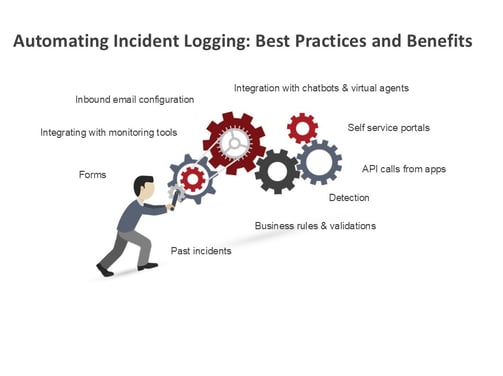Knowledge Hub
Expert insights, best practices, and valuable resources to enhance ServiceNow product suite implementation journey.
Automating Incident Logging: Best Practices and Benefits


Automating incident logging and categorization within the ServiceNow product suite can significantly enhance response times, reduce manual effort, improve data accuracy, and streamline issue resolution. Below are key objectives and best practices:
Key Objectives
Faster Issue Detection & Response: Enable real-time issue identification, reducing the time between detection and resolution.
Reduced Manual Effort: Minimize IT team workload by automating data entry and leveraging past data/knowledge base solutions in ServiceNow.
Improved Data Accuracy: Eliminate human errors, standardize categorization, prioritization, and ensure critical information (e.g., system details, logs, timestamps) is captured.
Proactive Problem Management: Identify recurring issues through pattern recognition for long-term problem resolution.
Enhanced SLA Compliance: Reduce downtime and improve SLA adherence by accelerating incident resolution.
Automating the Incident Logging Process
Integration with Monitoring Tools: Connect ServiceNow with monitoring tools or custom applications to automatically create incidents based on alerts.
Inbound Email Configuration: Configure inbound email actions to generate incidents from user-reported issues.
Chatbots & Virtual Agents: Use AI-driven chatbots to collect initial details and log incidents efficiently.
Self-Service Portals: Provide predefined issue templates to simplify user-reported incidents.
API-Based Incident Creation: Enable external applications to directly create incidents in ServiceNow via API calls.
Examples / Use Cases for Automated Incident Logging
Notify the infrastructure/application team when CPU utilization exceeds 80%.
Trigger an alert when a healthcare MRI machine overheats or malfunctions.
Detect and flag high-value transactions in a banking system for potential fraud.
IoT sensors trigger alerts for equipment breakdowns or anomalies.
⚠ Note: Define threshold limits, rules, and validations to prevent duplicate or false-positive incidents.
Incident Categorization & Routing
Proper categorization is crucial for directing incidents to the right teams and ensuring automation achieves its objectives.
Define Business Rules: Auto-assign categories and subcategories based on keywords, affected CIs, user inputs, or data sources.
Leverage Predictive Intelligence: Utilize ServiceNow’s Predictive Intelligence to classify incidents based on historical data.
Dynamic Forms & Auto-Fill Data: Automatically populate fields based on integration sources, detection services, and user inputs.
Intelligent Routing & Notifications: Assign incidents to the appropriate team based on predefined rules and notify them accordingly.
Overall Benefits of Automated Incident Logging
Real-time incident logging with minimal manual intervention
Faster response times, improved SLA compliance, and enhanced user satisfaction
Reduced false positives by validating alerts with threshold limits and business rules
info@praanshinfosys.com
© 2025. All rights reserved.
Solutions
ServiceNow IT Service Management
ServiceNow IT Operations Management
ServiceNow IT Asset Management
ServiceNow Strategic Portfolio Management
ServiceNow IT Governance, Risk and Compliance
ServiceNow HR Service Delivery
ServiceNow Workspace Service Delivery
ServiceNow Customer Service Management


